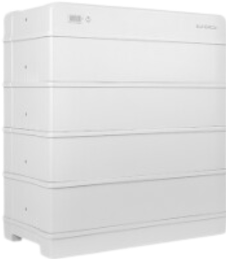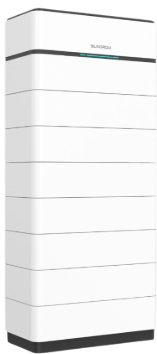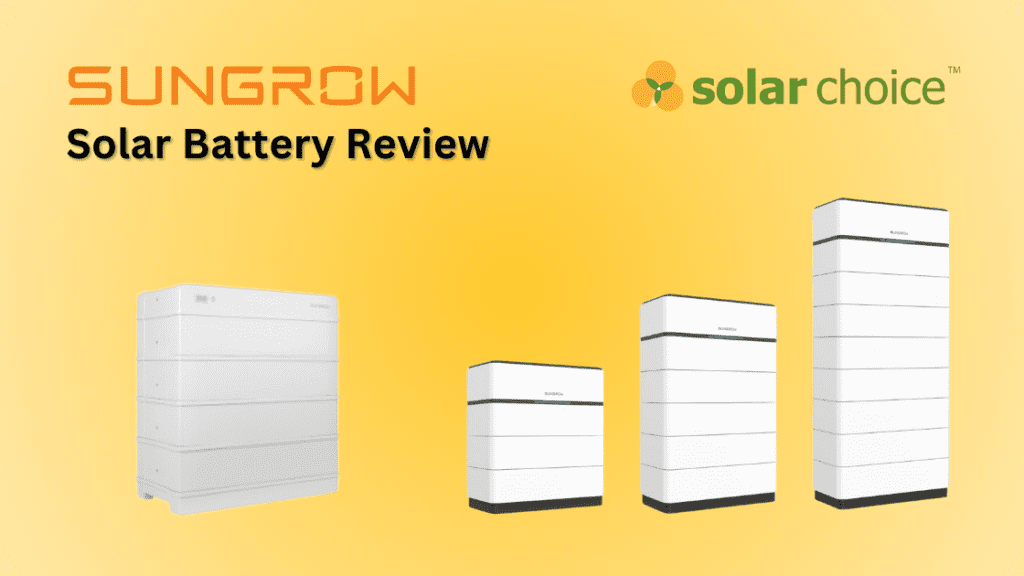Note: Solar Choice is not affiliated with Sungrow Batteries or any other battery manufacturer, so our reviews reflect an unbiased assessment of information on their products.
Who is Sungrow? Company Overview

Sungrow were founded in 1997 in China and have grown to be one of the biggest Chinese brands in the solar market.
The company is also well established in Australia with a local office based in North Sydney with staff able to assist with technical issues and sales support.
We dive into all the technical and commercial aspects of the batteries in our Sungrow battery review below.
Sungrow Battery Points of Difference
There are a few things that help Sungrow stand out from the competition
Stackable Batteries
Sungrow has adopted the stackable and modular approach to battery storage. Their batteries come in ‘towers’ which you can stack up to 8 modules on top of each other. This makes installation easy as one installer can complete the installation by themselves, unlike the Tesla Powerwall for example which requires 2 installers to lift the unit.
This also makes it very easy to expand the battery capacity in the future by dropping another battery module to your stack. This still needs to be completed by a qualified electrician.
Lithium Iron Phosphate (LiFePO4) Battery Chemistry
Lithium Iron Phosphate has now become the most popular battery chemistry for its stable characteristics and high depth of discharge. Sungrow have adopted LFP across all the batteries they have launched in Australia since 2018.
Sungrow’s Range of Batteries in Australia
Sungrow currently has 2 main battery models that are available in Australia – the SBH series and the SBR series. Lets find out the difference and what would best suit your needs.
SBR Series

The SBR series features individual battery modules of 3.2 kWh (usable). You will require at least 2 modules in your stack, so the battery solution starts with a minimum capacity of 6.2 kWh and can increase in 3.2kWh increments to a maximum of 25.6kWh.
The battery has a depth of discharge (DoD) of 100% which means you can make use of all the battery capacity. Typically DoD for batteries is between 70% and 100%. The battery solution is IP55 rated meaning it can be installer inside or outside.
Each battery module weighs 25kg so in theory, one installer can complete the installation by themself.
SBH Series

Sungrow’s SBH series starts at a minimum battery size of 2 x 5kWh battery modules. You can add additional modules to the ‘stack’ all the way to 40 kWh. This is designed for large residential or small commercial applications.
The battery features the same stackable design with each battery module weighing 45kg, meaning you can’t get away with just one installer. The battery has the same 100% depth of discharge and environmental rating of IP55.
Each battery module can be continuously charged or discharged at 50A or 3.54kW which means the battery can be discharged rapidly in under 2 hours which is an important feature in commercial applications.
How much does a Sungrow Battery cost?
As we’ve seen in the Solar Choice Battery Price Index, the cost of batteries has remained somewhat steady since 2008. However there’s been an array of rebates come out in individual states which has improve the end cost to consumers.
Currently based on data from Solar Choice’s network of battery installers, the average cost of a 9.6kWh Sungrow SBR battery is $10,694 including installation.
Please note that costs in your circumstances will vary based on installation requirements, products and which installer you use.
Compare quotes from qualified installers online.
Sungrow’s warranty for Australian customers
Sungrow’s currently available SBH and SBR series come with a 10 year product warranty which covers manufacturing defects. This is broadly the expectation of solar batteries in the Australian market. It should be noted that Sungrow’s previous low voltage model (SBP4K8) only offered a 5-year product warrranty.
As of the 1st of October 2024, Sungrow have improved their performance warranty to meet the eligibility requirements of the NSW Solar Battery rebate. The 10 year performance warranty guarantees that the battery will retain 70% of its initial capacity at the end of 10 years or 4,000 cycles of the product (whichever comes first). The 4,000 cycles more than covers an expected battery usage of 1 cycle per day (3,650 cycles over 10 years).
It should be noted that Sungrow excludes the labour, freight and waste disposal associated with any warranty claims after 5 years. So if your battery breaks down in years 5 – 10 you are still likely to be up for a fair bit of costs to repair the battery even if its covered. This is not like-for-like with many other 10-year battery warranties which will cover all of this cost for 10 years.
Sungrow do have a local office and support team to assist with warranty claims based out of their office in Sydney.
Read Sungrow’s full warranty policy on their website.
Pros and Cons of Sungrow Batteries
Pros
- Competitive price
- Batteries are modular and stackable – lower installation costs and easy to expand in the future
Cons
- Batteries are DC-connected so not a good option if you already have solar installed without a hybrid sungrow inverter
- 10-year warranty policy excludes a lot in years 5 to 10
Conclusion: Are Sungrow batteries a good option?
If you’re looking to get solar panels and a battery installed (no existing system) then a Sungrow inverter and battery combination are likely to be one of the better options to consider. Sungrow are a big name in the solar industry and have been around for a long time with a pretty good reputation. They battery solutions offer a cost-effective solution.
If you have solar installed already and are looking to add a battery, or would prefer to go for a more premium battery option then Sungrow batteries are probably not the right fit for you. Their ‘lite’ 10 year product warranty leaves a bit to desired.
Read more product reviews from Solar Choice
Since 2008 our knowledge and sophisticated software has allowed over 300,000 Australian households and businesses to make a well-informed choice on their solar & battery installer.
- Solar Panel Costs: Solar Choice Price Index | April 2025 - 1 April, 2025
- Solar Panels For Homes – All You Need to Know About Solar Systems - 18 March, 2025
- Best NSW Solar Feed-In Tariffs - 17 March, 2025
